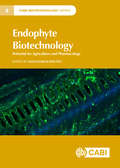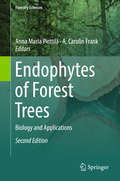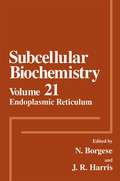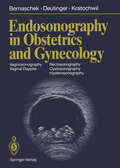- Table View
- List View
Endomitose und endomitotische Polyploidisierung (Protoplasmatologia Cell Biology Monographs #6 / C)
by Lothar GeitlerEndophyte Biotechnology: Potential for Agriculture and Pharmacology (CABI Biotechnology Series)
by Alec Baird Gabriele Berg Alessandro Bergna John R. Caradus Tomislav Cernava Sang Cho Stéphane Compant Amanda F. Currie Sherif S. Ebada Weaam Ebrahim Alan C. Gange Pablo A. García-Parisi Zachery Gray Evan Groover Roman Harto Marian Hsieh Linda J. Johnson Jutta Ludwig-Müller Katie Malmberg Ryan Manglona Malia Mercer Christina A. Müller Natalie Nasman Tatiana Nicklason Melanie M. Obermeier Marina Omacini Peter Proksch Peter Fredman Melissa Rienstra Rusty Rodriguez Jessica-Rose Spong Corinne Vacher Alex Van Inwegen Andy VanHooser Christin ZachowEndophytes are bacterial and fungal microorganisms that colonize plants without usually eliciting visible disease symptoms but establishing intricate and mutually beneficial interactions with their host plant. This can lead to an increase in plant vigour, growth, development, and changes in plant metabolism. Endophytes may assist in the development of more productive and sustainable agricultural practices or discoveries of novel pharmacologicals. These elusive organisms are often overlooked and their benefits underrated. Endophytes can support plants in a variety of ways to cope with biotic and abiotic stress factors, such as drought, heat, pest and diseases. They can produce particular metabolites, facilitate access to nutrients, change the plant's chemistry, physiology and responses, or by a combination of these factors. The biosynthetic pathways present in endophytes alone or in combinations with the plant's, can lead to novel chemicals, with yet undiscovered pharmacological characteristics. With state-of-the-art knowledge on their discovery and roles, this book describes the diversity of endophytes, their value, exploitation and future challenges. Key features: Provides an overview of the endophytes that are encountered in nature. Demonstrates the beneficial effects of endophytes together with their practical applications in agriculture. Explores how endophytes are valuable candidates for research on future drugs and biopesticides. This title is a valuable resource for students and researchers in plant science and plant pathology as well as those working in the pharmaceutical and pesticide industries.
Endophytes: Volume 1 (Sustainable Development and Biodiversity #15)
by Dinesh K. MaheshwariThis book discusses the latest developments in our understanding of microbial endophytes, their ecology, diversity and potential biotechnological applications. It covers all the latest advances concerning the endophytic interaction of microorganisms in a wide array of plants, reported on by experts from the entire globe. The diverse microbial community, which consists of archaeal, bacterial, fungal and protistic taxa, can be found in all plants. The endophytic lifecycle reveals how microorganisms play essential roles in plant growth, fitness and diversification. Diversity is an integral component of ecology. In soil ecology, below-ground interactions of plant and microorganisms are accomplished by endophytes, which reside in the plant’s internal tissues. The microbial world in general and endophytes in particular reflect a unique degree of genetic and functional (metabolic) diversity.Currently, significant attention is being paid to endophytic microorganisms, as their repertoire of cells and metabolites hold immense potential with regard to biotechnological applications for sustainable development. The diversity of bacterial endophytes guarantees that there are endophytes capable of forming compatible associations with all agronomically important plants, including monocots and dicots. The study of endophytes’ diverse nature in connection with biodiesel, medicinal and agriculturally important crop can lead to a better understanding of applicable facets. The topics in this dynamic field of study are so diverse and vast. This volume will benefit all botanists, microbiologists, ecologists, plant pathologists, physiologists, agronomists, molecular biologists, environmentalists, policymakers, conservationists and NGOs working to protect species and prevent the loss of biologically significant genetic material.
Endophytes: Volume 2 (Sustainable Development and Biodiversity #16)
by Dinesh K. Maheshwari K. AnnapurnaThis book reviews the latest developments in our understanding of microbial endophytes and their potential applications in enhancing productivity and disease protection. It covers all the latest discoveries regarding endophytes, their interactions with plants and application in agricultural productivity and protection. Our understanding of endophytes has increased exponentially in recent decades. These microbes, such as fungi, bacteria, and actinobacteria, establish a symbiotic or parasitic association with plants. A better understanding of endophytic microorganisms may help to elucidate their functions and potential role in developing sustainable systems of crop production and improved protection against biotic stresses. Endophytes play a vital role in plant growth and health promotion. Endophytic bacteria are of agrobiological interest because they create host-endophyte relationships, which can open exciting prospects for newer biotechnological applications. Endophytes have also proven to be a beneficial and sustainable alternative to agrochemicals due to their role in the biocontrol of pests and diseases. Further, endophytes are essential to the production of several secondary metabolites in grasses, in the process of gummosis in trees, and the production of useful metabolites such as alkaloids, pestaloside, cryptocandin, enfumafungin, subglutinols, etc. for the host plant. They are also involved in the production of enzymes, biosurfactants, biocontrol agents and plant growth promoters. As such, it is imperative that we explore these products’ industrial applications in the fields of biotechnology, pharmacy and agriculture.This volume will offers a valuable guidance for botanists, microbiologists, biotechnologists, molecular biologists, environmentalists, policymakers, conservationists, and those working for the protection of plant species of agricultural and medicinal importance.
Endophytes: Potential Source of Compounds of Commercial and Therapeutic Applications
by Ravindra H. Patil Vijay L. MaheshwariThis book describes the various therapeutic and commercial applications of compounds produced by endophytes. Endophytes are microorganisms that reside in the living internal tissues of plants without showing any apparent symptom of their presence. During their life cycle, they establish a symbiotic or parasitic relationship with the host plant. The book discusses different kinds of compounds that these endophytes produce, and their potential properties such as antimicrobial, anti-oxidative, anti-inflammatory, anticancer, neutraceutical, immunomodulatory etc. Other prospects of entophytic biology such as fungi of wild and domesticated crop plants and their applications in sustainable agriculture have also been included. The book also provides details about various techniques used in endophyte research, metabolite detection and bioactivity-based assays to explore endophytes. Endophytes with phytohormones‐producing potential and their role in plant —microbial interactions under stress are also discussed. The book also highlights novel strategies to tap into the hidden potential of endophytic fungi for the production of novel biomolecules using an integrated approach.These microorganisms have attracted a lot of scientific attention worldwide because of their huge potential for novel phytochemicals, pharmaceuticals and lead compounds. Hundreds of new novel endophytic fungi have been isolated, identified and systematically studied in last decade. However, this is the first of its kind, systematic compilation of potential biotechnological applications of endophytic compounds. Chapter contributions from groups across the globe make this book very up-to-date and informative. This book is very useful and interesting for students and researchers in the field of microbiology, plant sciences, mycology and pharmacology. It is also helpful for industry experts working on developing novel compounds.
Endophytes: Mineral Nutrient Management, Volume 3 (Sustainable Development and Biodiversity #26)
by Dinesh Kumar Maheshwari Shrivardhan DheemanThe challenges to meet the food requirement of the burgeoning population and stabilized productivity of agriculture lands can only be met by a second green revolution. After steadily declining for over a decade hunger is on the rise again, affecting million people of the global population. Therefore, crop yields must be increased substantially over the coming decades to keep pace with global food demand. The plant rhizosphere is a multidimensional and dynamic ecological environment of complicated microbe–plant interactions for harnessing essential macro and micronutrients from a limited nutrient pool. This book will showcase naturally-occurring endophyte which can be explored for nutrient mineralization and mobilization for sustainable agriculture. This will cover recent trends, prospects, critical commentaries and advancement in the research area focusing on naturally-occurring beneficial endophytic microbes. Thus, it is proposed to bring out new scientific insights and frontiers of research that have exploration of endophyte for mineral nutrient management in soil and crops. The chapters are contributed by leading scientists across the globe. The book will be useful to agronomists, microbiologists, ecologists, plant pathologists, molecular biologists, environmentalists, policy makers, conservationists, and NGOs working for the crop production and productivity development and consequently over all agricultural significance.
Endophytes of Forest Trees: Biology and Applications (Forestry Sciences #80)
by Anna Maria Pirttilä and A. Carolin FrankFound in every plant species, the diversity of endophytic micro-organisms can be extremely high within different plant organs and tissue types. In trees, their ecological roles with respect to host tree can vary from latent pathogens or saprophytes to neutral commensalists and mutualists. Given their high diversity, and their bio-active nature, endophytes are currently being associated with a role in tree health against insect herbivores and fungal pathogens, as well as improving tree properties in phytoremediation. Meanwhile there is increasing interest in the potential of some tree endophytes as new sources of drug compounds.The first book on tree endophytes in several years, and containing contributions from leading authors in the field, this book provides an important reference text for professional researchers and advanced students.
Endophytes of Forest Trees: Biology and Applications (Forestry Sciences #86)
by Anna Maria Pirttilä A. Carolin FrankEndophytes are commonly known as microorganisms, mainly bacteria and fungi, which live inside plant tissues without inducing symptoms. Considering the long-lived trees, endophytes have a fundamental role in preparing their hosts to face extreme weather conditions, drought, heat, cold, and pathogen and herbivore attacks. The current knowledge clearly demonstrates the importance of endophytes in shaping the plant diversity in a forest. Endophytes have an important capacity for biocontrol of forest diseases. Considering endophyte diversity and the range of various compounds and enzymes they can produce, endophytes can be used for various biotechnological applications.
Endophytes of the Tropics: Diversity, Ubiquity and Applications
by Adeline Su TingEndophytes of the Tropics: Diversity, Ubiquity and Applications® is a presentation of consolidated information on endophytes from the tropical region. It provides a glimpse of the various species of endophytes in the tropics, their host plants, their applications in the various field, and some of the challenges in endophytic research. In short, this book presents an overview of and the future of endophyte research in the tropics. The book offers comprehensive coverage of the most essential topics, including: Diversity of endophytes in the tropics Beneficial application of tropical endophytes or their derivatives Highlights on some valuable endophytic species from the tropics Some commercialized products based on tropical endophytes Challenges in researching endophytes Remedial strategies to advance research on tropical endophytes This books stands apart from others as it highlights on endophytes of the tropical regions, associating the uniqueness of tropical endophytes with the rich plant diversity and ethnobotanical history. There is therefore greater possibility that novel metabolites can be isolated from the endophytes, which can be explored and harnessed for the benefit of mankind.
Endophytes of the Tropics: Diversity, Ubiquity and Applications
by Adeline Su TingEndophytes of the Tropics: Diversity, Ubiquity and Applications® is a presentation of consolidated information on endophytes from the tropical region. It provides a glimpse of the various species of endophytes in the tropics, their host plants, their applications in the various field, and some of the challenges in endophytic research. In short, this book presents an overview of and the future of endophyte research in the tropics. The book offers comprehensive coverage of the most essential topics, including: Diversity of endophytes in the tropics Beneficial application of tropical endophytes or their derivatives Highlights on some valuable endophytic species from the tropics Some commercialized products based on tropical endophytes Challenges in researching endophytes Remedial strategies to advance research on tropical endophytes This books stands apart from others as it highlights on endophytes of the tropical regions, associating the uniqueness of tropical endophytes with the rich plant diversity and ethnobotanical history. There is therefore greater possibility that novel metabolites can be isolated from the endophytes, which can be explored and harnessed for the benefit of mankind.
Endophytic Fungi: The Hidden Sustainable Jewels for the Pharmaceutical and Agricultural Industries (Fungal Biology)
by Bhim Pratap Singh Ahmed M. Abdel-Azeem Vibhav Gautam Garima Singh Santosh Kumar SinghEndophytes have unique characteristics to propagate inside host plants and aide the host by providing additional defense against environmental stresses and phytopathogens. Among endophytes, endophytic fungi have been recognized as a proliferating source for the production of bioactive compounds with potential in both the agricultural and health industries.Excessive use of pesticides in agriculture as well as in the food supply chain have led to increased antimicrobial resistance (AMR), which is one of the more serious global health concerns. Endophytic fungi and their associated bioactive substances have been reported to show natural ability to fight against pathogens and can reduce the development of AMR in nature. Studies also reported their potential as producers of hormones that enhance plant growth and several compounds having biological activities without any adverse effects.This book covers the pharmaceutical potential offungal endophytes as elucidated through advanced bioinformatics tools and modern techniques. Also synthetic drugs are losing their efficacy to treat microbial-induced disease due to this emergence of drug-resistant microbes. Therefore, insight into the detection of valuable plant constituents is a pressing priority in order to achieve effective pharmaceutical treatments. This book provides lucid discussion of the most recent research and provides knowledge about the applications of endophytic fungi with a specific focus to their pharmaceutical potential.
Endophytic Microbes: Isolation, Identification, and Bioactive Potentials (Springer Protocols Handbooks)
by A. Sankaranarayanan Natarajan Amaresan Mitesh Kumar DwivediThis volume provides basic insight and protocols relating to endophytic microbes. Chapter are divided into five major sections detailing basic isolation, bioactive metabolites production. endophytism, isolation and identification of endophytes, bioactive potentials, and screening of metabolites. Authoritative and cutting-edge, Endophytic Microbes: Isolation, Identification, and Bioactive Potentials aims to provide comprehensive and accessible methods to undergraduate, graduate, and established scientist.
Endoplasmic Reticulum Stress in Health and Disease
by Patrizia Agostinis and Samali AfshinThe Endoplasmic Reticulum (ER) is an organelle with extraordinary signaling and homeostatic functions. It is the organelle responsible for protein folding, maturation, quality control and trafficking of proteins destined for the plasma membrane or for secretion into the extracellular environment. Failure, overloading or malfunctioning of any of the signaling or quality control mechanisms occurring in the ER may provoke a stress condition known as ‘ER stress’. Accumulating evidence indicates that ER stress may dramatically perturb interactions between the cell and its environment, and contribute to the development of human diseases, ranging from metabolic diseases and cancer to neurodegenerative diseases, or impact therapeutic outcome. This book primarily focuses on the pathophysiology of ER stress. It introduces the molecular bases of ER stress, the emerging relevance of the ER-mitochondria cross-talk, the signaling pathways engaged and cellular responses to ER stress, including the adaptive Unfolded Protein Response (UPR), autophagy as well as cell death. Next the book addresses the role of ER stress in physiology and in the etiology of relevant pathological conditions, like carcinogenesis and inflammation, neurodegeneration and metabolic disease. The last chapter describes how ER stress pathways can be targeted for therapeutic benefit. Altogether, this book will provide the reader with an exhaustive view of ER stress biology and the latest insights in the role of ER stress in relevant human diseases.
Endoscope in knee
by Sheffield Vi ServiceThis is a side view diagram of an endoscope inserted into a knee joint to enable examination. On the top left of the page is a lamp emitting light through a fibre optic cable to the right to illuminate the knee joint on the centre right of the page. On the bottom left of the page is a video camera which receives the image of the inside of the knee joint through a fibre optic cord to the right.
Endoscopic Ultrasound Management of Pancreatic Lesions: From Diagnosis to Therapy
by Antonio Facciorusso Nicola MuscatielloThis book provides a comprehensive and up-to-date overview of current endoscopic ultrasound use in all aspects of pancreatology, from diagnosis to therapy, i.e., from tissue acquisition, with standard fine-needle aspiration and the newer biopsy needles, to less invasive techniques such as contrast-enhanced ultrasound and elastography. It also covers novel therapeutic strategies, with a particular focus on ablative treatments and lumen-apposing stents, and describes techniques developed by the editors, in particular combined celiac plexus neurolysis with pancreatic tumor ethanol ablation and elastography-guided fine-needle aspiration. All topics are developed by pursuing an evidence-based approach and several recent meta-analyses, the majority of which were published by the authors. Due to several recent advances in the field, endoscopic ultrasound has taken on a pivotal role in the diagnosis, staging, and treatment of pancreatic lesions; as such, the present volume offers an invaluable tool for staying abreast of the state-of-the-art in this field.
Endoscopy (Handbuch der Urologie Encyclopedia of Urology Encyclopedie d'Urologie #6)
by Roger W. Barnes R.T. Bergman H.L. HadleyEndosomes (Molecular Biology Intelligence Unit)
by Ivan DikicEndosomes are a heterogeneous population of endocytic vesicles and tubules that have captivated the interest of biologists for many years, partly due to their important cellular functions and partly due to their intriguing nature and dynamics. Endosomes represent a fascinating interconnected network of thousands of vesicles that transport various cargoes, mainly proteins and lipids, to distant cellular destinations. How endosomes function, what co-ordinates the molecular determinants at each step of their dynamic life cycle and what their biological and medical relevance is, are among the questions addressed in this book.
Endosonography in Obstetrics and Gynecology
by Gerhard Bernaschek Josef Deutinger Alfred KratochwilMore than 25 years ago, when ultrasound diagnostic methods were first intro duced into gynecology and obstetrics, few of the pioneers of these techniques sus pected what importance sonographic diagnosis was destined to assume. It was soon recognized that the organs of the lesser pelvis could be visualized to much greater advantage by inserting probes into the natural bodily orifices than by abdominal sonography. Full exploitation of the physical properties of ultra sound had to wait, as so often in the history of sonography, for technological ad vances. Endosonography in the form available to us today combines the advantages of endoscopy and sonography. The next light-reflecting surface, once the limit of en doscopy, represents no barrier to ultrasound. A whole range of both diagnostic and therapeutic procedures can be sonographically guided. Blood flow in vessels lying deep in the lesser pelvis can now be measured by means of vaginal duplex sonography.
Endosperm: Developmental and Molecular Biology (Plant Cell Monographs #8)
by Odd-Arne OlsenThe nutritive endosperm of angiosperms is mankind’s most important source of food, livestock feed and industrial raw material. This book is the first comprehensive overview of the developmental and molecular biology of endosperm. The text covers cereal endosperm development from fertilization to maturity, including molecular and cell biology of the syncytial phase. It also goes into the cellularization process and cell fate specification of the embryo surrounding region cells, the basal transfer cells, the starchy endosperm and aleurone cells.
Endospore-forming Soil Bacteria (Soil Biology #27)
by Niall A. Logan and Paul VosAerobic endospore-forming bacteria are found in soils of all kinds, ranging from acid to alkaline, hot to cold, and fertile to desert. It is well known that endospores confer special properties upon their owners and play dominant parts in their life cycles and dispersal, and much has been written about the spores, genetics, and economic importance of these organisms. Much has also been written about soil ecology, but there is a relative dearth of literature that brings together different aspects of the behaviour and characters of endospore-formers with their contributions to soil ecosystems. This Soil Biology volume fills that gap. Following chapters that describe the current classification of these organisms, that review methods for their detection and for studying their life cycles in soils, and that examine their dispersal, other chapters show that they are active and dynamic members of soil floras that interact widely with other soil inhabitants, with roles in nitrogen fixation, denitrification, and soil remediation.
Endosymbionts in Paramecium (Microbiology Monographs #12)
by Masahiro FujishimaEndosymbiosis is a primary force in eukaryotic cell evolution. In order to understand the molecular mechanisms involved in this mutualistic relationship, experiments to reproduce endosymbiosis are indispensable. The ciliate "Paramecium" is an ideal host for performing such studies. Topics presented in this volume are: the origins of algal and bacterial symbionts in "Paramecium", the diversity of endosymbiotic bacteria, such as "Holospora" bacteria and especially "Chlorella" species, as well as the infection and maintenance processes. The metabolic control, the regulation of circadian rhythms and photobiological aspects of the mutualistic association, as well as the killer effect of "Paramecium" and its causative agents are further points discussed.
Endosymbiose der Tiere mit Pflanzlichen Mikroorganismen (Lehrbücher und Monographien aus dem Gebiete der exakten Wissenschaften #12)
by P. BuchnerEndosymbiosis
by Wolfgang LöffelhardtThe origin of energy-conserving organelles, the mitochondria of all aerobic eukaryotes and the plastids of plants and algae, is commonly thought to be the result of endosymbiosis, where a primitive eukaryote engulfed a respiring α-proteobacterium or a phototrophic cyanobacterium, respectively. While present-day heterotrophic protists can serve as a model for the host in plastid endosymbiosis, the situation is more difficult with regard to (the preceding) mitochondrial origin: Two chapters describe these processes and theories and inherent controversies. However, the emphasis is placed on the evolution of phototrophic eukaryotes: Here, intermediate stages can be studied and the enormous diversity of algal species can be explained by multiple secondary and tertiary (eukaryote-eukaryote) endosymbioses superimposed to the single primary endosymbiotic event. Steps crucial for the establishment of a stable, mutualistic relationship between host and endosymbiont, as metabolic symbiosis, recruitment of suitable metabolite transporters, massive gene transfer to the nucleus, development of specific translocases for the re-import of endosymbiont proteins, etc. are discussed in individual chapters. Experts, dealing with biochemical, genetic and bioinformatic approaches provide insight into the state of the art of one of the central themes of biology. The book is written for graduate students, postdocs and scientists working in evolutionary biology, phycology, and phylogenetics.
Endosymbiotic Organelle Acquisition: Solutions to the Problem of Protein Localization and Membrane Passage
by Steven D. Schwartzbach Peter G. Kroth Miroslav OborníkThis volume provides in depth reviews of the protein targeting translocation processes, gene transfer processes and genome reduction processes in the host and in the endosymbiont which were likely utilized during the evolution of an endosymbiont into mitochondria, mitochondria related organelles, simple and complex chloroplasts. These reviews cover both the current understanding of the host processes as well as the evolutionary outcomes used by these organelles for protein targeting and translocation. Reviews of the current knowledge of these topics are plentiful but scattered throughout the bacterial, parasite, plant and animal literature; here, reviews of current knowledge with evolutionary outcomes and future perspectives, written by leading researchers in their respective areas, are united into one comprehensive volume, essential for students and scientists interested in or working onsubcellular protein localization, protein targeting signals, translocation of proteins across and insertion into membranes, nucleic acid transfer between genomes, genome reduction and evolution of mitochondria and chloroplast.























